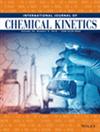HO 2•$_{2}^{\bullet}$+O3→ OH•+2O2反应:大气中振动热OH自由基的潜在来源
IF 1.5
4区 化学
Q4 CHEMISTRY, PHYSICAL
引用次数: 0
摘要
在目前的工作中,使用飞行中的经典轨迹计算和量子化学计算,我们已经表明HO 2•$_{2}^{\bullet}$+O3→ OH•+2O2反应可能是振动激发OH自由基的潜在来源。研究表明,OH自由基主要产生在Γ=1和Γ=2状态。我们还表明,在Nelson和Zahniser的气相实验中,振动热的OH自由基是解释观察到的16OH•分支分数的关键(J.Phys.Chem.1994,982101–2104)。最后,我们通过将标题反应与已知在大气中产生热OH自由基的其他化学反应进行比较,讨论了标题反应对大气的影响。本文章由计算机程序翻译,如有差异,请以英文原文为准。
HO
2
•
$_{2}^{\bullet }$
+O3 → OH•+2O2 reaction: A potential source of vibrationally hot OH radicals in the atmosphere
In the present work, using on-the-fly classical trajectory calculations along with quantum chemical computation, we have shown that HO+O3→ OH•+2O2 reaction can be a potential source of the vibrationally excited OH radical. The investigation suggests that OH radical will be majorly produced in ν=1 and ν=2 states. We have also shown that the vibrationally hot OH radical is key in interpreting the observed branching fraction of 16OH• in the gas phase experiment of Nelson and Zahniser (J. Phys. Chem. 1994, 98, 2101–2104). Lastly, we have discussed the atmospheric implications of title reaction by comparing it with other chemical reactions known to produce hot OH radical in the atmosphere.
求助全文
通过发布文献求助,成功后即可免费获取论文全文。
去求助
来源期刊
CiteScore
3.30
自引率
6.70%
发文量
74
审稿时长
3 months
期刊介绍:
As the leading archival journal devoted exclusively to chemical kinetics, the International Journal of Chemical Kinetics publishes original research in gas phase, condensed phase, and polymer reaction kinetics, as well as biochemical and surface kinetics. The Journal seeks to be the primary archive for careful experimental measurements of reaction kinetics, in both simple and complex systems. The Journal also presents new developments in applied theoretical kinetics and publishes large kinetic models, and the algorithms and estimates used in these models. These include methods for handling the large reaction networks important in biochemistry, catalysis, and free radical chemistry. In addition, the Journal explores such topics as the quantitative relationships between molecular structure and chemical reactivity, organic/inorganic chemistry and reaction mechanisms, and the reactive chemistry at interfaces.

 求助内容:
求助内容: 应助结果提醒方式:
应助结果提醒方式:


